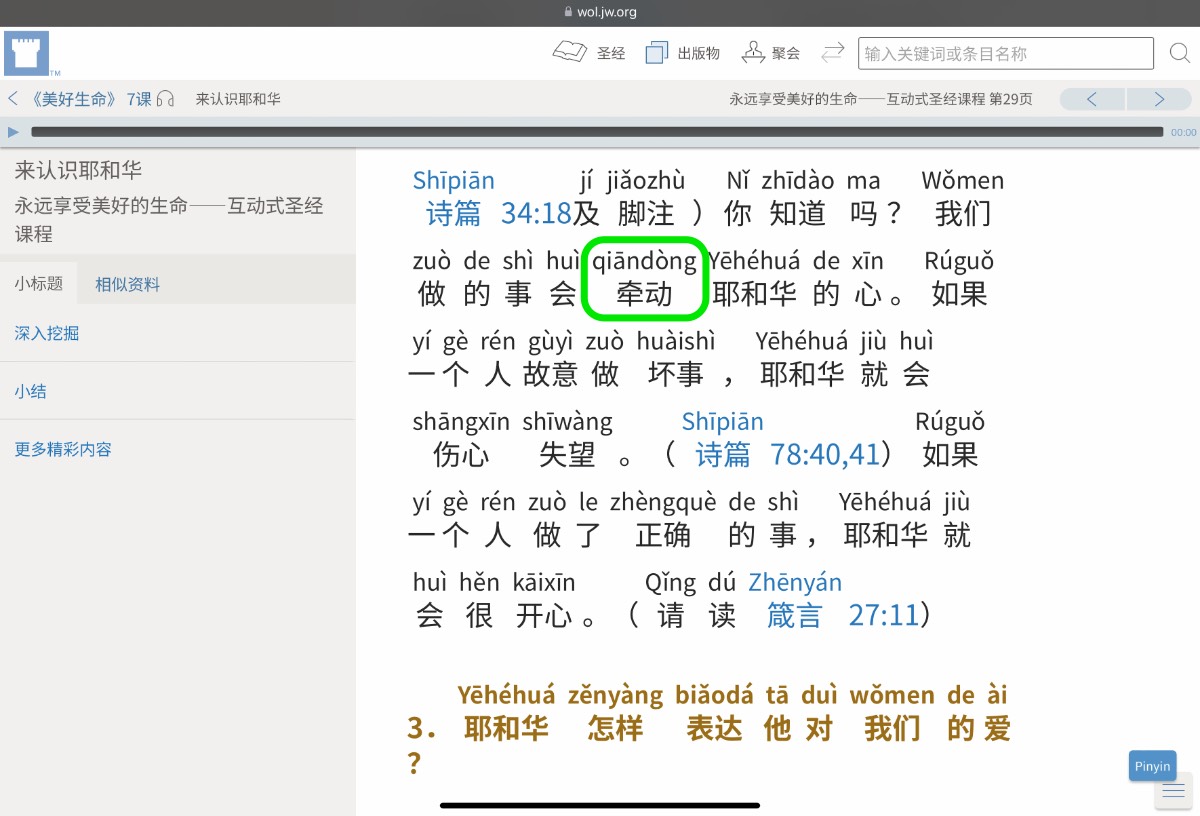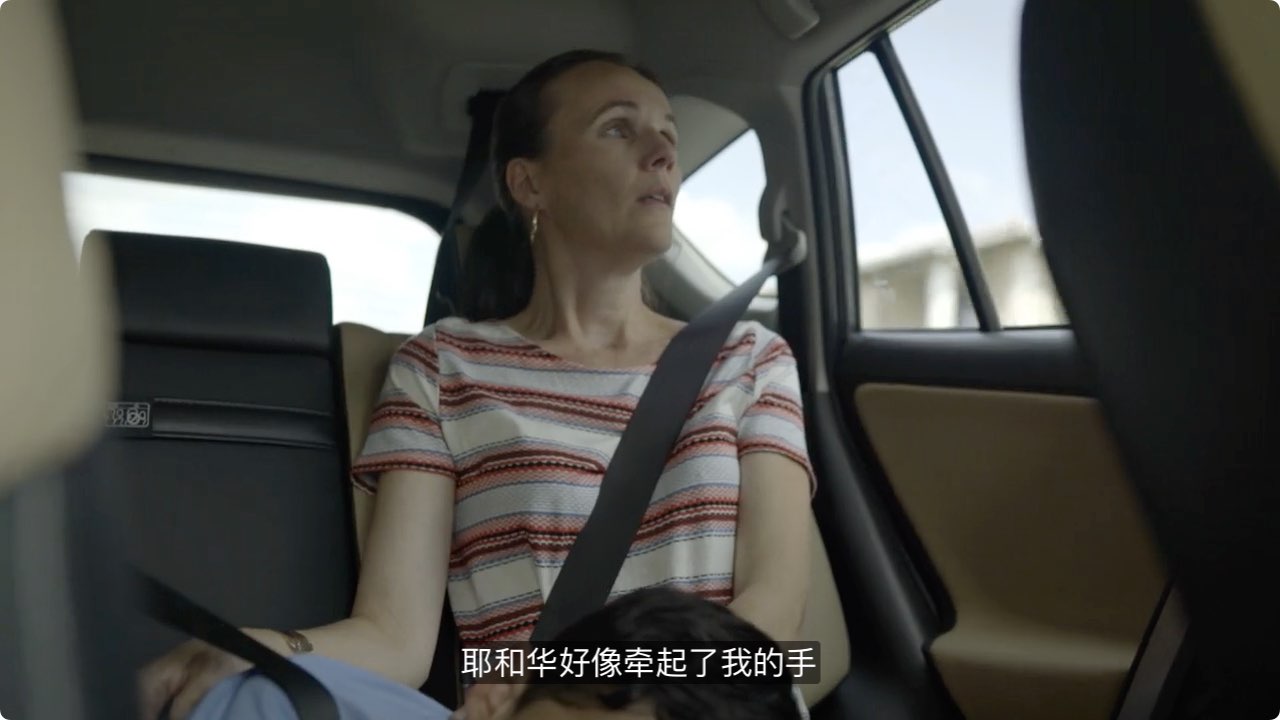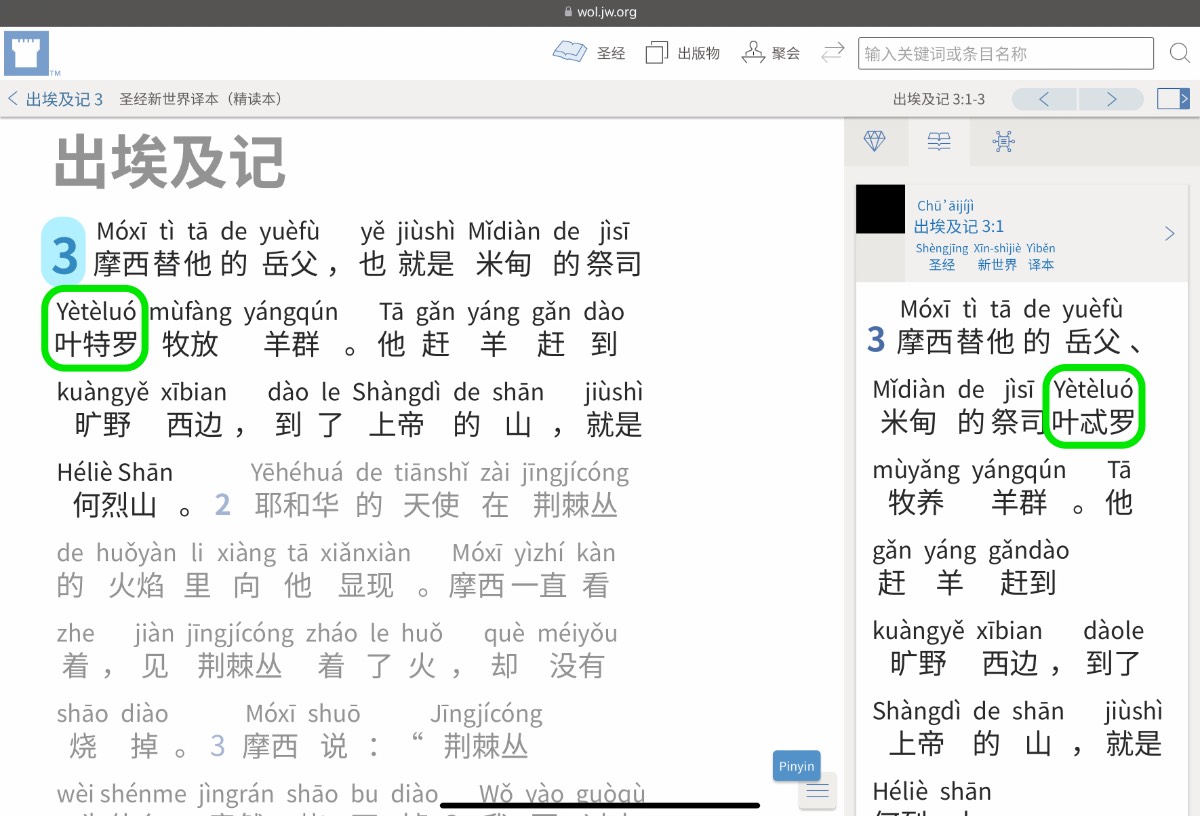qiāndòng (qiān·dòng {lead along}; pull · {to be moved} → [affect; influence; produce a change] 牵动 牽動) ← Tap/click to show/hide the “flashcard”
[Notes: Tap/click on a Pīnyīn (Pīn·yīn {Piecing Together of} · Sounds → [Pinyin] 拼音) expression to reveal its “flashcard”; tap/click on a “flashcard” or its Pīnyīn (Pīn·yīn {Piecing Together of} · Sounds → [Pinyin] 拼音) expression to hide the “flashcard”. 📖 📄 📘 icons mean 📖 Reveal All, 📄 Reveal Advanced, and 📘 Reveal None re all the “flashcards” in the heading, paragraph, etc. that they are placed at the beginning of.]
One of the publications that is now recommended to be used on Bible studies is the Yǒngyuǎn Xiǎngshòu Měihǎo de Shēngmìng—Hùdòng Shì Shèngjīng Kèchéng ((Yǒng·yuǎn Eternally · {Far (in Time)} 永远 永遠) (Xiǎng·shòu Enjoy · Receive 享受) (Měi·hǎo Beautiful · Good 美好) (de ’s 的) (Shēngmìng Life 生命)—(Hù·dòng {Each Other} · Moving → [Interactive] 互动 互動) (Shì (Type 式) (Shèng·jīng Holy · Scriptures → [Bible] 圣经 聖經) (Kè·chéng Lessons · Procedure → [Course] 课程 課程) → [Enjoy Life Forever!—An Interactive Bible Course (lff)]) (Enjoy Life Forever! (lff)) book. This week’s MEotW, “qiāndòng (qiān·dòng {lead along}; pull · {to be moved} → [affect; influence; produce a change] 牵动 牽動)”, appears in lesson 07, point 2 of this book:

The Pīnyīn (Pīn·yīn {Piecing Together of} · Sounds → [Pinyin] 拼音) Plus material for the context in which “qiāndòng (qiān·dòng {lead along}; pull · {to be moved} → [affect; influence; produce a change] 牵动 牽動)” occurs is as follows:
📖 📄 📘 Nǐ (you 你) zhīdào (zhī·dào {did know} · {(the) way (of it)} → [did know] 知道) ma ([? ptcl for “yes/no” questions] 吗 嗎)? Wǒmen (Wǒ·men we · [pl] 我们 我們) zuò (do 做) de (’s 的) shì (things 事) huì (will 会 會) qiāndòng (qiān·dòng pull · {to be moved} → [affect] 牵动 牽動) Yēhéhuá (Jehovah 耶和华 耶和華) de (’s 的) xīn (heart 心).
For comparison, here is the corresponding English sentence:
And did you know that Jehovah is affected by the way we act?
It seems that this is the first time that “qiāndòng (qiān·dòng {lead along}; pull · {to be moved} → [affect; influence; produce a change] 牵动 牽動)” has appeared in one of the publications recommended by the organization for use on Bible studies. It has been used in official publications to represent how music can move people, and as shown above, it’s good to know as a word that expresses how Jehovah’s heart can be moved by what we do.
“Jehovah Was Holding My Hand”
The “qiān ({lead along (by holding the hand, etc.)}; pull 牵 牽)” in “qiāndòng (qiān·dòng {lead along}; pull · {to be moved} → [affect; influence; produce a change] 牵动 牽動)” means “lead along (by holding the hand, etc.); pull”, and it also appears in the expression “qiānqile (qiān·qi·le {lead along (by holding the hand, etc.)}; pulled · {to be rising → [up]} · {to completion | [indicates a change]} 牵起了 牽起了)”, which is used in the video for lesson 09, point 6 of the Enjoy Life Forever! book:

📖 📄 📘 Yēhéhuá (Jehovah 耶和华 耶和華) hǎoxiàng (hǎo·xiàng {well → [very much]} · {was like} 好像/象) qiānqile (qiān·qi·le {leading along (by holding the hand, etc.)} · {to be rising → [up]} · [indicates a change] 牵起了 牽起了) wǒ de ((wǒ me 我) (de ’s 的) → [my]) shǒu (hand 手),
The corresponding English text is:
Jehovah was holding my hand,
Moving
After watching the above-mentioned video, you might very well feel moved, and if you can speak Mandarin, you might say:
📖 📄 📘 Wǒ (I 我) tīngdào (tīng·dào heard · {arriving at} 听到 聽到) zhèige (zhèi·ge this · [mw] 这个 這個) jīnglì (jīng·lì {gone through (thing)} · experience → [experience] 经历 經歷) zhīhòu (zhī·hòu ’s · {after (that)} 之后 之後), hěn ({very much} 很) gǎndòng (gǎn·dòng feel · moved 感动 感動).
The “dòng (move [→ [stir | arouse | change; alter]] 动 動)” in “gǎndòng (gǎn·dòng feeling · moved | {make to feel} · {to be moved} 感动 感動)”, used above, is the same one that is used in “qiāndòng (qiān·dòng {lead along}; pull · {to be moved} → [affect; influence; produce a change] 牵动 牽動)”.
This “dòng (move [→ [stir | arouse | change; alter]] 动 動)”, which basically means “move”, also appears in a variety of other Mandarin expressions, such as:
- tuīdòng (tuī·dòng push · {to be moving} 推动 推動)
- dòngjī (dòng·jī moving · intention → [motive; motivation; intention] 动机 動機)
- huódòng (huó·dòng living · moving → [activities] | {to be living → [to be moving]} · {to move} 活动 活動)
- dòngcí (dòng·cí moving · word → [verb] 动词 動詞)
- dòngwù (dòng·wù moving · thing → [animal] 动物 動物)
- yùndòng (yùn·dòng carrying; transporting · moving → [exercising | sports; athletics; exercise | motion; movement | movement; campaign; drive] 运动 運動)
- zhǔdòng (zhǔ·dòng {(being) master} · moving → [taking the initiative] 主动 主動)
This “dòng (move [→ [stir | arouse | change; alter]] 动 動)” was also discussed in the MEotW post on “hùdòng (hù·dòng mutually; {[(with)] each other} · moving → [interacting; interaction; interactive] 互动 互動)”.
For convenience:
The direct link for the current generation Pīnyīn (Pīn·yīn {Piecing Together of} · Sounds → [Pinyin] 拼音) Plus resource for the Enjoy Life Forever! book is:
The short link for Chinese field language-learning links for the Enjoy Life Forever! book is:
More Pīnyīn (Pīn·yīn {Piecing Together of} · Sounds → [Pinyin] 拼音) and Pīnyīn (Pīn·yīn {Piecing Together of} · Sounds → [Pinyin] 拼音) Plus web material based on the Mandarin Enjoy Life Forever! book will be made available in the Pīnyīn (Pīn·yīn {Piecing Together of} · Sounds → [Pinyin] 拼音) Plus web resource as time allows.
